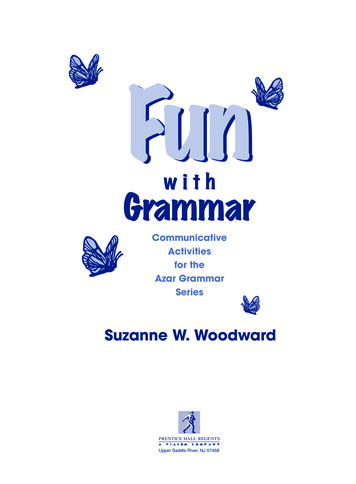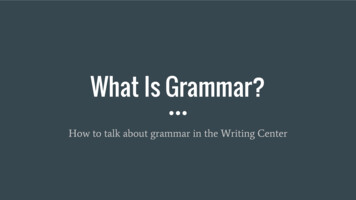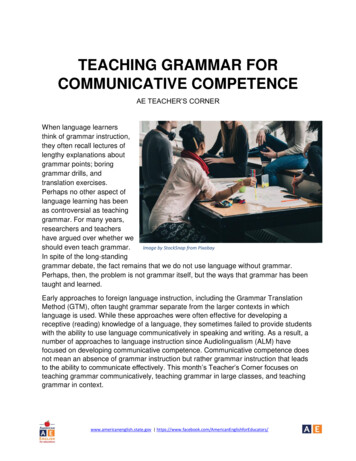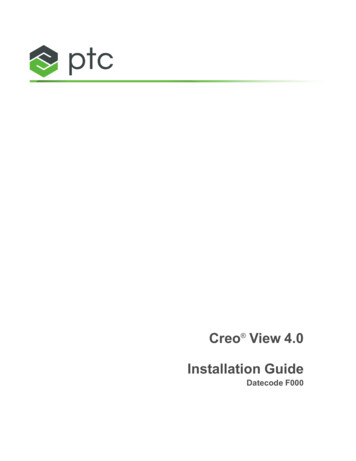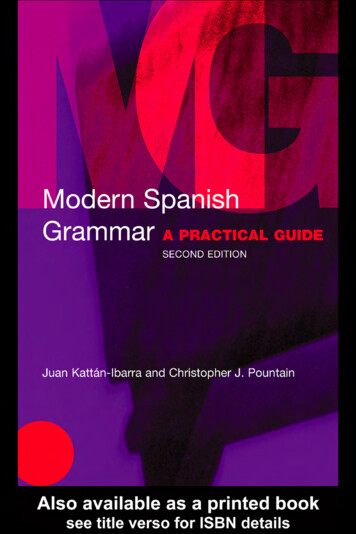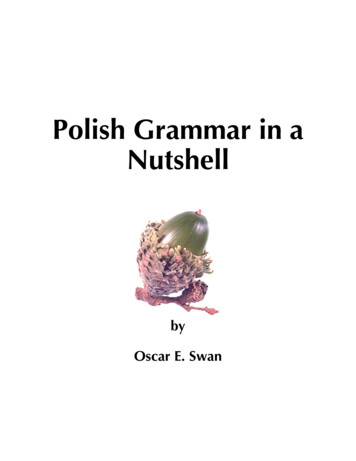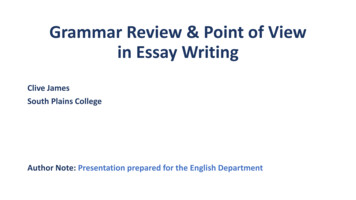
Transcription
Grammar Review & Point of Viewin Essay WritingClive JamesSouth Plains CollegeAuthor Note: Presentation prepared for the English Department
Grammar Review: SPC English DepartmentEssay Grading Standards To evaluate essays, the SPC English department uses: A Set of Uniform Standards to: Demonstrate a basic level of competence in college-level writing Teach an appropriate foundation for writing in academic andprofessional environments
Essay Grading Criteria Essays are evaluated on four bases: Unity Support Coherence Sentence skills The criteria considered in each baseinclude: characteristics essential to thesuccess of an essay Depending on the assignment: certain bases and criteria may beweighted more than others and the instructor's assignmentmay establish additional, morespecific criteria
Base 1: UnityBody Paragraph StructureThesisA body paragraph includes:The thesis statement: concisely expresses the main idea ofthe essay is appropriate for the assignment and establishes a sustained andconsistent focus for the paper. The thesis may preview the supportingideas a main idea expressed in a topicsentence strongly tied to the statedthesis unified supporting details and clear connections among ideasPurpose and Audience The content and style are tailored for a specific purpose and audience
Base 2: Support Details/Development: A well-developed essay: supports the thesis withample evidence uses a variety of specificexamples, facts, or otherdetails and explains theevidence to show itsconnections to the thesis Use of Sources: Logic: The essay presents clear: If research is used, theessay: sophisticated,insightful ideas thatrecognize: accurately quotesand paraphrasescredible sources the complexity of thetopic without: effectively balancessource material withthe writer’s ownideas inaccuracies or errorsin reasoning and cites anddocuments as perthe requiredstandards of thestyle (MLA/APA)
Base 3: Coherence Organization and Transitions The essay demonstrates: a logical progression of ideas provides clear and smooth transitionsamong ideas uses structure appropriate to anacademic essay. Title, Introduction, and Conclusion An appropriate title is provided An introduction captures the reader’sattention transitions to the topic by giving contextor background information and presents the thesis statement. A conclusion reemphasizes the essay’sthesis and main ideas and provides asense of closure.
Base 4: Sentence Skills Use of Standard American English without major errors, such as: FragmentFaulty Parallelism MechanicsDangling Modifiers Wrong WordComma-Splice Error PunctuationSubject-Verb Agreement Fused SentencesPronoun-Antecedent Agreement Point of ViewIncorrect Verb Usage
Base 4: Sentence Skills (Cont.)Word Choice & Sentence Variety The student writes in a: consistent, academic tone using varied sentence structure accurate and precise word choiceFormat The essay is formatted according to: the standards set forth in theassignment in the syllabus or in the required style guide (MLA,APA)
Grammar Review – Fragments What are Sentence Fragments? Fragments are: grammatically incomplete sentencesphrases and dependent clauses.the grammatical structures that cannot stand on their ownones that need to be connected to an independent clause to work Difference between a sentence and a sentence fragment: a sentence missing one of its crucial elements: a subject, a verb, or a complete thought Missing a subject: Missing a verb: Not expressing a complete thought:Slammed the door and left.The answer to our prayers.Since she never saw the movie. Note: Length is not an indication of a sentence fragment: She ran. Which is why we believe the proposed amendments should be passed.
Common Causes of Fragments Incorrect use of Non-finite verbs (gerunds, participles, and infinitives) can oftentimes lead to fragments Non-finite verbs don’t act like verbs, and thus not counted as verbs while identifying a phrase or a clause Let’s look at a few examples of these: Running away from my mother. To ensure your safety and security. Beaten down since day one. Even though all of the above have non-finiteverbs, they’re phrases, not clauses In order for these to be clauses, they would need an additionalverb that acts as a verb in the sentence Words like “since,” “when,” and “because” turn an independent clause into a dependent clause. For example: “I was a little girl in 1995” is an independent clause. “Because I was a little girl in 1995” is a dependent clause.
Identifying Fragments Incorrect use of Relative pronouns, like “that” and “which,” can often lead to fragment errors: Which I prefer to keep secret. Coordinating conjunctions (FANBOYS) can also cause problems A sentence starting with a coordinating conjunction should be followed by a complete clause, not just a phrase: Because the one I have isn’t working too well. As his girlfriend chased him down the hall screaming her head off. Keep in mind that command sentences are not fragments, despite not having a subject Commands are the only grammatically correct sentences that lack a subject, because the subject is implied: Drop and give me fifty!
Fixing Sentence Fragments Example 1: Sue appeared at the committee meeting last week. And made a convincing presentation of her ideas aboutthe new product. There is no subject in this phrase, so the best fix is to simply omit the period and combine the two statements: Sue appeared at the committee meeting last week and made a convincing presentation of her ideas about thenew product. Example 2: The committee considered her ideas for a new marketing strategy quite powerful. The best ideas that theyhad heard in years. The part after the period, “the best ideas they had heard in years,” is simply a phrase— there is no verb containedin the phrase. By adding “they were” to the beginning of this phrase, we have turned the fragment into an independent clause,which can now stand on its own: The committee considered her ideas for a new marketing strategy quite powerful; they were the best ideasthat they had heard in years.
Mechanics – Spelling Errors Phonetic Errors: Phonetics is a field that studies the sounds of a language A word: can sound like it could be spelled multiple ways “Concede” and “conceed” sound the same phonetically, but only “concede” is the proper spelling has silent letters that the writer may forget to include You cannot hear the “a” in “realize,” but you need it to spell the word correctly has double letters that the writer may forget to include “Accommodate,” for example, is frequently misspelled as “acommodate” or “accomodate.” The writer may use double letters when they are not needed: The word “amend” has only one “m,” but it is commonly misspelled with two.
Mechanics – Homophones & Typographical Errors Homophones: Two words with different meanings but the same pronunciation are homophones “Bread”and “bred” sound the same, but they are spelled differently. Common homophones include: right, rite, wright, and writeread (most tenses of the verb) and reedread (past, past participle) and redrose (flower) and rose (past tense of rise) Typographical Errors: Some spelling errors are caused by the writer accidentally typing the wrong thing Common typos include: Omitting letters from a word (typing “brthday” instead of “birthday,” for example)Adding extra letters (typing “birthdayy”)Transposing two letters in a word (typing “brithday”)Spacing words improperly (such as “myb irthday” instead of “my birthday”)
Mechanics – Capitalization & Proper Noun Capitalize the first word when: Starting a Sentence: The Pronoun “I” Quoting Others: Directly quoted speech is capitalized if it is a full sentence. The head chef said to me, “Anyone can become a good cook if they are willing to learn.” Proper Nouns: Names and Nicknames People, Person’s Culture and Languages Geographical Names, the names of cities, states, countries, continents, etc. Organizations, Government agencies, institutions, and companies Days, Months, Holidays, Religions Titled Work
Mechanics – Abbreviations and Acronyms An abbreviation is the shortened form of a word or phrase: Most abbreviations are formed from a letter or group of letters taken from the original word In academic papers, only commonly used but relatively minor words are abbreviated, such as “km” for “kilometer” or “Dr.” for “doctor.” Style Conventions for Abbreviations: Abbreviations should be capitalized just like their expanded forms would beIf the original word or phrase is capitalized, then you should capitalize the abbreviation, and vice versaAbbreviations usually end with a period, particularly if they were formed by dropping the end of a wordWhen a sentence ends with an abbreviation, use only one period for both the abbreviation and the sentence She lives in N.Y. (New York is abbreviated as “N.Y.” In this example, it comes at the end of the sentence but there is only one period.)He got a ticket for going 70 mph when the speed limit was 55. (Miles per hour is abbreviated “mph.” Note that it is not capitalized.) Acronyms are abbreviations that form another word: acronyms act as shorthand for longer terms, particularly those a writer wants to reference frequentlyLaser is so frequently used as a word that few people know it is an acronymLaser stands for “light amplification by stimulated emission of radiation.”However, they do not always form another wordOftentimes, acronyms are formed from the initial components of a series of wordsThese components are usually individual letters, but some may use the first syllables of words Acronyms in Academic Writing: acronyms can be used to stand in for job titles (such as CEO), statistical categories (such as RBI) or the names of organizations (such as FBI) Other instances may arise depending on the type of paper you are writing—a scientific essay, for example, might have acronyms for the namesof chemical compounds or scientific terms Jonathan recently joined the American Association of Retired Persons (AARP).
Mechanics – Numbers & Numerals Numbers as Words: In academic writing, numbers of one or two words should be spelled out with letters Anthony was able to bike five miles in less than an hour. Notice that 5 is written out as “five” because it is one word Maria bought five bananas, two bunches of grapes, and six oranges. She needed twenty-one servings for the luncheon. Notice that each number is written out, including 21, because all of them are one or two words Numbers as Numerals: Numbers that are more than two words long should be written as numerals. Our vacation to North Carolina ended up being 728 miles, as a round trip. Or, in the case of years: “Tony was born in the fall of 1966.” Also, the following numbers are written as numerals: Dates:Addresses:Percentages:Fractions and decimals:Scores:Statistics:Surveys:Exact amounts of money:Divisions of books:Divisions of plays:Time of day:December 7, 1941, 32 BC, AD 1066119 Lakewood Lane, 1600 Pennsylvania Avenue45 percent or 45%1/3 and 0.2520 to 13 or 15–18average age 252 out of 5 861.34 or 0.67volume 6 or chapter 5act 2, scene 412:00 AM or 4:35 PM
Punctuations
Punctuation - Comma Errors in punctuation can often have unintended meanings For example, consider the difference the comma makes in the following sentences: Let’s eat, Grandpa Let’s eat Grandpa The comma in the first sentence indicates that you are addressing Grandpa and telling him that you’d like to eat. The lack of a comma in the second sentence makes this sentence sound like you are considering cannibalism. Common reasons for Comma Use: While using a transition word or phrase that creates a natural pause While writing a lengthy, complex sentence with multiple subjects and verbs While providing a list of three or more related items or phrases in a row. Common Scenarios for Comma Use: Comma after Introductory Element Unnecessary Comma Missing Comma Joining Two Independent Clauses with Coordinating Conjunctions Missing Comma in Compound Sentence
Punctuation – Fixing Commas Comma After Introductory Element: Introductory words and phrases—any words or phrases that come before the main clause in a sentence—should be set off with a comma. Here is an example of a sentence that does not include the required comma and then the correction: (Missing Comma) In case you were wondering I never allow myself to be exposed to direct sunlight unless I have my scarf, mysunglasses, and a large umbrella. Correction: In case you were wondering, I never allow myself to be exposed to direct sunlight unless I have my scarf, my sunglasses,and a large umbrella. Unnecessary Comma: We all tend to forget that the comma rules all depend upon the situation. Avoid using a comma to join two independent clauses, using coordinating conjunctions, such as “before,” “and,” “but,” or “so” everytime. I have a wide variety of supernatural powers, but wish I had the power to go out in the daylight. In this example, you don’t need a comma before the but because you aren’t combining two independent clauses Here is a corrected version of the sentence: I have a wide variety of supernatural powers but wish I had the power to go out in the daylight. Pay attention while using commas unnecessarily around information that is essential to the sentence. The comma rule is that non-essential information should be set off with commas, but essential information should not
Punctuation – Missing Comma in Compound Sentences Missing Comma: Remember to put commas around information that is non-essential or nonrestrictive Here is an example of a sentence without proper commas around the nonrestrictive element: Moving into a cave especially one that is already occupied is not a decision one should make without considerable forethought. Moving into a cave, especially one that is already occupied, is not a decision one should make without considerable forethought. When you join two independent clauses (complete sentences) with a coordinating conjunction (and, but, or, nor, for, so, yet—alsoknown as the FANBOYS), you must place a comma before the coordinating conjunction It is to help make a proper boundary between the two independent clauses Missing Comma in Compound Sentences: I understand that vampires need love but I don’t think they really understand just how attached I am to my vital, bodily fluids. In this example, the sentence is missing the comma before the “but” because the “but” joins two complete thoughts Leaving out this necessary comma creates an error because you have two sentences connected without a proper boundarybetween those sentences I understand that vampires need love, but I don’t think they really understand just how attached I am to my vital, bodily fluids.
Quick Guide to Commas Use commas to separate independent clauses when they are joined by any of these seven coordinating conjunctions: and, but,for, or, nor, so, yet Use commas after introductory a) clauses, b) phrases, or c) words that come before the main clause. Use a pair of commas in the middle of a sentence to set off clauses, phrases, and words that are not essential to the meaning ofthe sentence. Use one comma before to indicate the beginning of the pause and one at the end to indicate the end of the pause. Do not use commas to set off essential elements of the sentence, such as clauses beginning with that (relative clauses). That clauses after nouns are always essential. That clauses following a verb expressing mental action are always essential. Use commas to separate three or more words, phrases, or clauses written in a series. Use commas to separate two or more coordinate adjectives that describe the same noun. Be sure never to add an extra comma between the final adjective and the noun itself or to use commas with non-coordinateadjectives. Use a comma near the end of a sentence to separate contrasted coordinate elements or to indicate a distinct pause or shift. Use commas to set off phrases at the end of the sentence that refer back to the beginning or middle of the sentence. Such phrases are free modifiers that can be placed anywhere in the sentence without causing confusion. Use commas to set off all geographical names, items in dates (except the month and day), addresses (except the street numberand name), and titles in names. Use a comma to shift between the main discourse and a quotation. Use commas wherever necessary to prevent possible confusion or misreading
Punctuation – Semi-Colon The semicolon is one of the most misunderstood and misused punctuation marks; in fact, it is often mistaken for the colon. However, these two punctuation marks are not interchangeable. A semicolon connects two complete ideas (a complete idea has a subject and a verb) that are connected to each other. Anika’s statue is presently displayed in the center of the exhibit; this location makes it a focal point and allows it to direct the flow ofvisitors to the museum. The first idea tells us where Anika’s statue is, and the second idea tells us more about the location and it’s importance. Each of these ideas could be its own sentence, but by using a semicolon, the author is telling the reader that the two ideas areconnected. Often, you may find yourself putting a comma in the place of the semicolon; this is incorrect. Using a comma here would create a run-on sentence Remember: a comma can join a complete idea to other items while a semicolon needs a complete idea on either side. The semicolon can also be used to separate items in a list when those items have internal commas. For example, say you’re listing a series of cities and their states, or you’re listing duties for a resume: As a photographer for National Geographic, Renato had been to a lot of different places including São Paulo, Brazil; Kobe, Japan; Kyiv,Ukraine; and Barcelona, Spain. As an engineering assistant, I had a variety of duties: participating in pressure ventilation surveys; completing daily drafting,surveying, and data compilation; and acting as a company representative during a roof-bolt pull test.
Punctuation - Colon The colon: well-loved but, oh, so misunderstoodThe colon is not just used to introduce a list; it is far more flexibleThe colon can be used after the first word of a sentence or just before the final word of a sentenceThe colon can also be used to introduce a grammatically independent sentenceThe colon is like a sign on the highway, announcing that something important is comingIt acts as an arrow pointing forward, telling you to read on for important information Use the colon when you wish to provide pithy emphasis. To address this problem, we must turn to one of the biologist’s most fundamental tools: the Petri dish. Use the colon to introduce material that explains, amplifies, or summaries what has preceded it. The Petri dish: one of the biologist’s most fundamental tools. In low carbon steels, banding tends to affect two properties in particular: tensile ductility and yield strength. The colon is also commonly used to present a list or series, which comes in handy when there is a lot of similarmaterial to join: A compost facility may not be located as follows: within 300 feet of an exceptional-value wetland; within 100 feetof a perennial stream; within 50 feet of a property line.
Run-on or Fused Sentences Run-on sentences occur when two or more independent clauses are improperly joined. One type of run-on that you’ve probably heard of is the comma splice, in which two independent clauses are joined by a comma without a coordinating conjunction(and, or, but, etc.) Often, choosing a topic for a paper is the hardest part it’s a lot easier after that.Sometimes, books do not have the most complete information, it is a good idea then to look for articles in specialized periodicals.She loves skiing but he doesn’t. Common Causes of Run-on Sentences We often write run-on sentences because we sense that the sentences involved are closely related, and dividing them with a period just doesn’t seem right. We may also write them because the parts seem too short to need any division, as in “She loves skiing but he doesn’t.”However, “She loves skiing” and “he doesn’t” are both independent clauses, so they need to be divided by a comma and a coordinating conjunction—not just acoordinating conjunction by itself.Another common cause of run-on sentences is mistaking adverbial conjunctions for coordinating conjunctions. For example if we were to write, “She loved skiing, however he didn’t,” we would have produced a comma splice.The correct sentence would be “She loved skiing; however, he didn’t.” Fixing Run-on Sentences Before you can fix a run-on sentence, you’ll need to identify the problemAre the parts of the sentence independent clauses, or are they dependent clauses or phrases?Remember, only independent clauses can stand on their ownThis also means they have to stand on their own; they can’t run together without correct punctuation Most of the hours I’ve earned toward my associate’s degree do not transfer, however, I do have at least some hours the university will accept.The opposite is true of stronger types of stainless steel they tend to be more susceptible to rust.
Comma-Splice Error A comma splice is particular kind of comma mistake that happens when you use a comma to join two independent clauses. When you join two independent clauses with a comma and no conjunction, it’s called a comma splice. Some people consider this a type of run-on sentence, while other people think of it as a punctuation error. A comma splice occurs when you use a comma to separate two independent clauses. A comma is not strong enough to perform this function, which causes the problem. It’s important to remember to use proper punctuation to separate your independent clauses; otherwise, you end up with a sentencelike this: He promised me, if I didn’t report him, he would never do it again, however, the next night, he was back, playing his bagpipes under mybalcony. Here, you should notice the only comma error is the one between again and however. He promised me, if I didn’t report him, he would never do it again; however, the next night, he was back, playing his bagpipes undermy balcony. Add a Conjunction One way to fix a comma splice is to add a conjunction immediately after the comma. With most comma splices, the conjunction you’llwant to add is probably and, but, or so. I am not angry with you, I am not happy with you, either. I am not angry with you, but I am not happy with you, either.
Pronoun-Antecedent Agreement Antecedent Clarity: An antecedent is the noun (or phrase) that a pronoun is replacing The phrase “antecedent clarity” means that it should be clear who or what the pronoun is referring to In this section we’ll examine some common sources of antecedent confusion and ways of addressing them Rafael told Matt to stop eating his cereal. Since both Rafael and Matt are singular, third person, and masculine, it’s impossible to tell whose cereal is being eaten Katerina was really excited to try French cuisine during her semester abroad. They make all sorts of delicious things. Make sure your pronouns always have antecedents. Make sure that it’s clear what their antecedents are. Antecedent Agreement When a pronoun matches the person and number of its antecedent, it agrees with its antecedent I hate it when Zacharias tells me what to do. He‘s so full of himself. The Finnegans are shouting again. I swear you could hear them from across town! When you choose a pronoun, you also need to make sure that you use the correct case. The three cases: subject, object, and possessive. The case of your pronoun should match its role in the sentence. For example, if your pronoun is doing an action, it should be a subject: He runs every morning. However, when something is being done to your pronoun, it should be an object: Dogs have always hated me.
Indefinite Pronouns – Person & Number Person and Number: Some of the trickiest agreements are with indefinite pronouns: Every student should do his or her best on this assignment If nobody lost his or her scarf, then where did this come from? As we learned earlier in this outcome, words like every and nobody are singular, and demand singular pronouns. Here are some of the words that fall into this category: anybody, each, someone, anyone, one, etc. Using “he or she” is correct (while they is incorrect) Anyone going on this hike should plan on being in the canyon for at least seven hours; he or she should prepare accordingly. I know somebody has been throwing his or her trash away in my dumpster, and I want him or her to stop. However, as you may have noticed, the phrase “he or she” (and its other forms) can often make your sentences clunky When this happens, it may be best to revise your sentences to have plural antecedents. Because “he or she” is clunky, you’ll often see incorrect workarounds like this: The way each individual speaks can tell us so much about him or her. It tells us what groups they associate themselves with, both ethnically and socially. As you can see, in the first sentence, him or her agrees with the indefinite pronoun each. However, in the second sentence, the writer has shifted to the plural they, even though the writer is talking about the same group of people.
Pronoun Case Case: You and I versus You and Me Some of the most common pronoun mistakes occur with the decision between “you and I” and “you and me.” People will often say things like “You and me should go out for drinks.” Or—thinking back on the rule that it should be “you and I”—they will say “Susan assigned the task to both you and I.” Remember that every time you use a pronoun you need to make sure that you’re using the correct case. In the first example, both pronouns are the subject of the sentence, so they should be in subject case: “You and I should goout for drinks.” In the second example, both pronouns are the object of the sentence, so they should be in object case: “Susan assigned thetask to both you and me.” Singular They or One One attribute of indefinite pronouns is that the person’s gender is unspecified —they are by definition indefinite. Consider the following statements in which the indefinite pronoun someone in the first sentence is also the antecedent for thepronouns in the second sentence: I hear someone coughing. I wish he or she would stop. “He or she” is grammatically correct here because it takes into account that the “someone” could be either gender. However, some use the masculine pronoun as the generic singular pronoun: To each his own. Everyone should get himself a new car at least once
Subject-Verb Agreement Tense Agreement: The basic idea behind sentence agreement is pretty simple: All the parts of your sentence should match (or agree) Verbs need to agree with their subjects in number (singular or plural) and in person (first, second, or third) In order to check agreement, you simply need to find the verb and ask who or what is doing the action of that verb I really am (first-person singular) vs. We really are (first-person plural) The boy sings (third-person singular) vs. The boys sing (third-person plural)Compound subjects are plural, and their verbs should agree A pencil, a backpack, and a notebook were issued to each student.Verbs will never agree with nouns that are in phrases. To make verbs agree with their subjects, follow this example: The direction of the three plays is the focus of my talk. When double checking for tense agreement, ask yourself, “Who (or what) is doing the action of the verb?”. The subject of “my talk” is the direction, not plays, so the verb should be singular In the English language, verbs usually come after subjects But when this order is reversed, make the verb agree with the subject, not with a noun that happens to precede it. Beside the house stand sheds filled with tools.The subject is “sheds”; it is plural, so the verb must be “stand”
Verb-Tense Consistency – Incorrect Verb UsageVerb Tense: Always be consistent with your verb tense If you’re writing in the present tense, be sure you stay in the present tense, and vice versa. The exception would be if you need to shift tenses to tell a story, but that would be purposeful shiftingShe grabs my hand then flipped me like I weighed nothing. It’s important to check verbs both for consistency and contextVerb Forms: These forms are created with different forms of to be and to have:He had eaten everything by the time we got there.She is waiting for us to get there When you combine a form of to be with the present participle, you create a continuous tense; these tenses indicate a sense of continuityThe subject of the sentence was (or is, or will be) doing that thing for awhile.Present:is workingPast:was workingFuture:will be working (You can also say “is going to be working.”) When you combine a form of to have with the past participle of a verb, you create a perfect tense; these tenses indicate a sense ofcompletionThis thing had been done for a while (or has been, or will have been).Present:has workedPast:had workedFuture:will have worked To have must always appear first, followed by the past participle been. The present participle of any verb can then followThese perfect continuous tenses indicate that the verb started in the past, and is still continuing:Present:has been workingPast:had been workingFuture:will have been working
ApostrophesWith possessives, the apostrophe is used in combination with an s to indicate that a word possesses
Grammar Review: SPC English Department Essay Grading Standards To evaluate essays, the SPC English department uses: A Set of Uniform Standards to: Demonstrate a basic level of competence in college-level writing Teach an appropriate foundat




